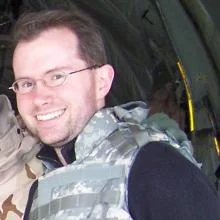When Dr. David A. Bray took the reins as the new CIO of the Federal Communications Commission last year, he spent some time listening and learning the history of the agency to find out more about the “health of the IT infrastructure” he had inherited. He learned the agency was saddled with 207 different legacy systems. That’s about one system for every eight employees in the 1,750-person agency.
In this interview, Bray shares his plan for updating those systems, including how he’s going to keep up morale during a difficult and risky transition. He also discusses how he’s going to ensure there’s a role for everyone once all the upgrades are complete.
Performing open-heart surgery for IT
The Enterprisers Project (TEP): Modernizing legacy IT systems is a huge priority for you in your new role. Can you give a brief overview of what you’re going to do?

Bray: Instead of spending a lot of time, energy, and resources modernizing each one of those 207 individual legacy systems — which would take quite some time and would just reinforce stovepipes — we want to create a cloud-based, common data platform. With this common data platform, we’ll take all the data that’s currently being stored in the aging, legacy IT systems, take it to the cloud, and over time build a very thin user interface with reusable code — ideally open source — to access that data. Over time, this will allow us to turn off the 207 different legacy systems, and give us one common data platform that maybe has 207 different processes interoperating at the data layer on that platform. That data will then be available, where appropriate, to the public, to our stakeholders and to other government agencies, with appropriate attribute-based, access controls. This supports open government initiatives as well as helps to break down any silos across the Commission’s 18 different Bureaus and Offices.
TEP: That sounds incredible. What’s the next step?
Bray: The next step is meeting with the team to provide a pep talk and say, “All right. Now that we know the ‘health’ of our patient, namely the FCC’s IT infrastructure, our next step is completing the specifics tied to a short- and long-term plan. That short-term plan will focus on stabilizing the infrastructure, specifically before mid-FY15 we will move the physical servers that we have here at the FCC off site to a commercial managed services vendor. Basically there won’t be anything stored here at headquarters in D.C. This will ‘stabilize’ the patient and also help FCC shift to IPv6. In talking with the team, they’re willing to work over the winter holidays if necessary, and if the commercially-managed vendor can support that accelerated time frame. The way I see it, it’s basically like doing ‘open-heart surgery for IT.’ We’re going to do the equivalent of a heart transplant on our servers. Obviously, there’s some risk involved with this, but at the same time, in order for the patient to get better, we have no choice. The longer-term, 24-month plan will then include the ‘shift’ of data to the cloud-based, common data platform and the rewrite of legacy systems as processes on that platform. This will get our ‘IT patient’ up and running.
Working through the holidays
TEP: How do you get a team jazzed to do that over the holidays? What’s your strategy for keeping morale up and getting it done?
Bray: The interesting thing, and it’s really a credit to the team, is that the team members were actually the ones who volunteered to do it over the holidays without me asking. We’re still nailing down the specifics about whether a vendor will support that accelerated time frame, but either way when they told me that they were willing to do that, I was like, “Wow! These folks are truly dedicated to making the legacy IT at FCC right.” It’s humbling, and I think that type of dedication communicates the palpable energy here to fix the aging IT at FCC.
At FCC, we’re fortunate to have a mix of people who have been here for a quite some time, the average time an employee’s been at the FCC is 15 1/2 years, in addition to several new people with new ideas and insights who have signed up within the last year. While obviously there’s been some friction between the old way of keeping the IT running and new IT to shift to the cloud, as a leader I’ve tried to manage this friction and say, “Look, we’re all going to have differing opinions, yet we all agree that the current state of aging, legacy IT systems is just not sustainable, so we’ve got to change.” Which everyone agreed. From that, the next question I’m asking everyone is “So what are our options?” And that’s where we are now, preparing for the equivalent of “open heart surgery” on the FCC’s legacy IT infrastructure. There’s risk with whatever we do: risk if we make the move, risk if we don’t move – yet I’m here because I’m not a status quo person. Personally I like tackling ‘near impossible’ situations that require you to think, act, and move forward as a team. I believe the FCC should be leading the way with its IT, and it’s rewarding to be able to be the human flak jacket for a team that is so excited about what we need to do together.
No one gets left out
TEP: If the average tenure for employees with the FCC is 15 1/2 years, how do you best fit in some of those longtime employees into this modernization strategy?
Bray: Yes, we literally have people who have been here for 30 years, 40 years, almost 50 years. They have seen the FCC evolve over time. They’ve put a lot of hard work and energy into the IT servers that are here. What was cutting-edge IT in the 1990s, are now legacy systems that are hard to keep running. So one of the things I’ve tried to do wherever possible is spend as much time listening and taking in people’s perspectives; seeking to understand before seeking to be understood. I also extend respect to all employees, particularly the ones who have been here for a while because they made this place run in the 1970s, the 1980s, and the 1990s. In addition, one question I ask each employee is “What brings you joy?” because that question demonstrates what motivates them, where they find passion, and where their skills might be. All of the employees here at FCC signed-up for public service for a reason. By asking about what brings each of them joy, I can find a way to align that energy to the mission ahead of us: ensuring that the FCC has IT for the opportunities of the next decade ahead.
Imagine the "art of the possible"
TEP: What other challenges are you facing as you look to upgrade these legacy systems?
Bray: First, we have to keep the Commission running while we make this shift, and the last few months have had a lot of ongoing activities in the midst of our upgrade efforts. Second, we’re working on creative ways to engage all of the FCC staff and external stakeholders in designing new systems. We’ve already started the process of engaging multiple stakeholders on improving the usability and searchability of the FCC.gov website. My job is really 20% technology—the other 80% involves people, processes, and performance. So when we make the shift to a cloud-based, common data platform, we need to think beyond the processes we used to do in the 1990s, which may have been dictated by limitations of technology back then. We’re working on creative ways to say, “Imagine the ‘art of the possible’ and forget about any possible limitations that currently exist. Just sketch out how you would like to do it, and then, behind the scenes, we will synthesize your ideas to figure out how to make what you envisioned occur. We want FCC staff and stakeholders to think outside the box and not be tied to how it used to be done in 1990s, particularly if those processes were human-intensive, involved a lot of manual paper sorting, or have become complicated as a result of additional layers being added over the last ten to fifteen years.”
A great analogy for legacy systems
TEP: You’ve also likened upgrading legacy systems to an iceberg, can you elaborate?
Bray: With the iceberg analogy, often times when looking at an organization’s budget we see the surface — the IT investments and the costs of those IT investments — but what we don’t see are the legacy manual processes, the human-intensive activity. The human time and costs with legacy manual processes aren’t necessarily being measured, but they’re there ‘underwater’ in budgets. If we work to dramatically reduce the time and costs of those legacy processes where possible, as well as lighten the human load required to complete the work, this can benefit the organization in dramatic ways. So that’s where the iceberg analogy comes in — it’s easy to spot the cost of IT in budget, however you don’t see the expensive manual processes, legacy operations, or human-intensive activities also in budgets under the water.
TEP: How do you plan to keep yourself pumped as you take on this enormous project?
Bray: For me, there is just such a joy in leading a team to tackle mission-focused projects that are near impossible, but not completely impossible, involving a mixture of both humans and technology. That is what gets me out of bed every morning and gets me pumped.
Dr. David A. Bray serves as Chief Information Officer (CIO) for the Federal Communications Commission, overseeing the Commission's efforts to modernize legacy systems and transform technology partnerships in telecommunications, broadband, competition, the spectrum, the media, public safety, and security. He was selected to serve as a member of the Council on Foreign Relations and as a Visiting Associate for the Cybersecurity Working Group on Culture at the University of Oxford in 2014.




